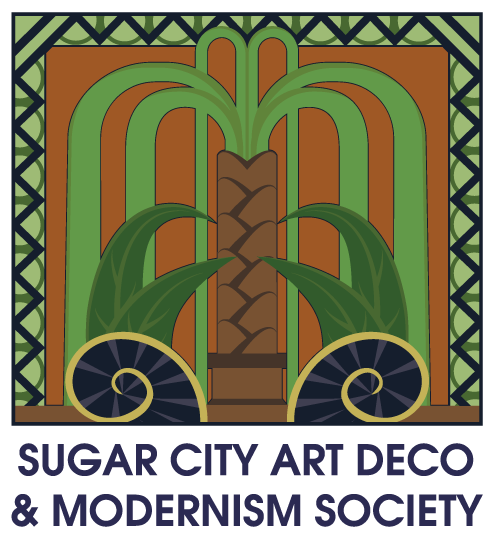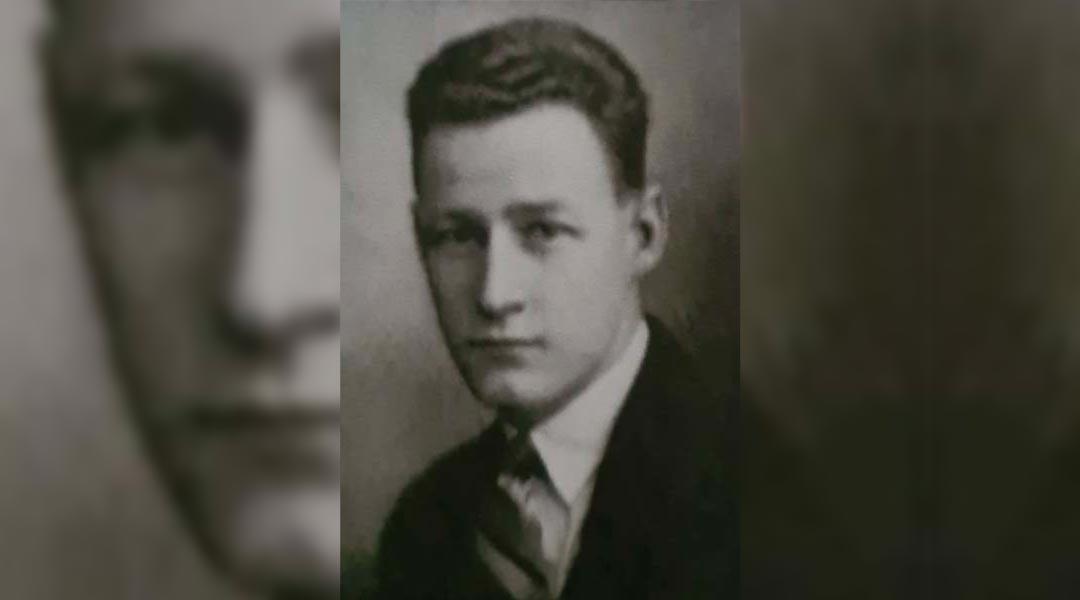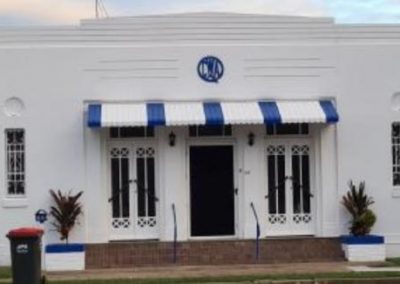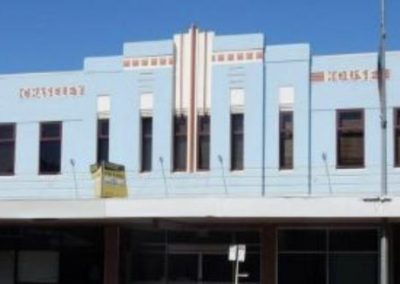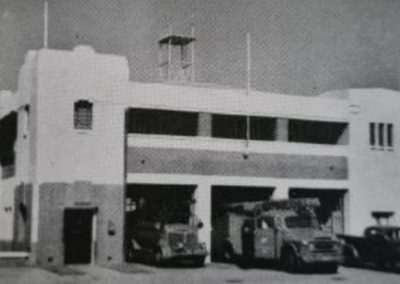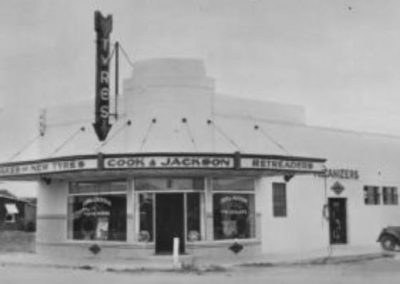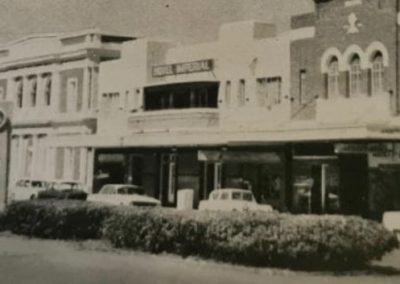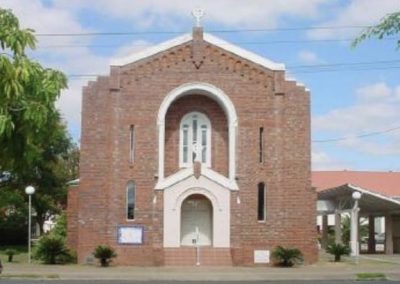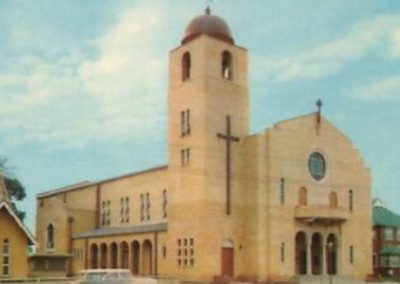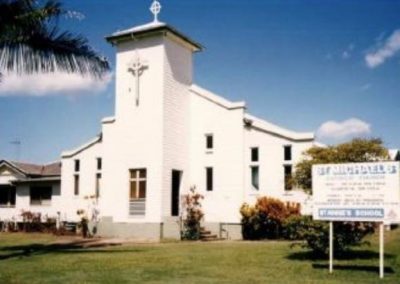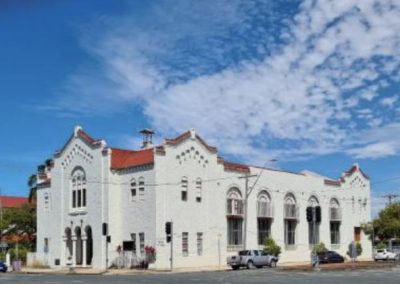“Mackay’s Architect”
By Nicholas McDougall of the Sugar City Art Deco & Modernism Society
The name Harold Vivian Marsh Brown may sound like a character from a Dickens novel, but this man was one of if not the most influential architect in the history of Mackay. The majority of his architectural achievements are now recognizable landmarks of Mackay. Most of Browns collection of buildings are entered in the local and state heritage registers for their significance of architectural achievement and contribution to the cultural development of the region.
Harold Vivian Marsh Brown was born in 1907 in Mackay, Queensland. Harold was the fourth son of James Vivian Brown, who was born in St Austell, Cornwall, England in 1860. James married Harold’s mother, Ethel Marsh, in 1891. Ethel was the daughter of William Marsh.Together with Charles Webster, Marsh co-founded the famous Mackay general store Marsh and Webster, which traded under that name until 1963 when David Jones purchased it.
Harold was educated at the Mackay state School and The Southport school then the Brisbane Technical College from 1926 to 1930 while being an articled pupil of Cavanagh and Cavanagh architects in Brisbane. The Cavanagh brothers were responsible for the design of several schools, hospitals and churches in Western Australia and Queensland. Specifically, they undertook several significant projects for the Roman Catholic Church, including the Bishop’s Palace, Church of the Oblate Fathers in Fremantle, the Redemptorist Monastery, North Perth, and St John of God Subiaco Hospital and St Mary’s Roman Catholic Church in Kalgoorlie.
In 1932 at the heights of The Depression HVM Brown, as he styled himself; returned to Mackay and set up his architectural practice from the family home in Brisbane Street.
Brown’s return to Mackay was fortuitous timing, for the city was going through a construction boom in the early 20th century. This was due to a series of unrelated events which combined to transform the appearance of the thriving City of Mackay. In 1915 and 1916 fires destroyed many of the commercial premises in Victoria Street. A devastating cyclone in 1918 destroyed 80% of the buildings in the city, thus leading the local Shire Council to implement a policy to replace all timber commercial premises with masonry structures for safety reasons. A population explosion in the early 20th century made Mackay the second fastest growing city in Queensland for more than a decade. The economy of the city was made by steady sugar prices and cooperative owned sugar mills which led to the money being retained within the community. The wealth and expansion of the Mackay City drew the attention of many other well-known Queensland architects, such as Lange Powell (The Dalrymple Building, Chambers & Powell 1917, National Bank of Australasia 1934, Holy Trinity Anglican church) and Edwin Orchard (The Palaces Hotel 1939, T&G Building 1937).
Between 1932 and 1940, Harold designed at least thirteen buildings in Mackay, including several excellent examples of the Art Deco style. At the height of his career, Brown was associated with almost one-third of all building projects in Mackay. Some of the most recognizable designs of Brown are the Holy Trinity Anglican Parish Hall, also known as Cloud Nine. Its design and contribution to the cultural identity of Mackay are now protected by Queensland state heritage legislation as part of the Holy Trinity church complex. In the mid-1930s the early Rectory was condemned and the hall, built in 1918, required significant repairs. The new hall was constructed in a style to complement the church, and it was proposed that the hall be built large enough for dances, meetings or general entertainment so that rental would pay off the building. The hall had 4000 square feet of floor space, a small hall for kindergarten, Sunday School and rooms for local guilds and meetings. The hall was built during 1937-38. The Premier W Forgan Smith, state member for Mackay specifically travelled to Mackay for the opening of the parish hall on 4 September 1937. The Rectory’s architectural plans came from a builder’s plan, it was constructed between the church and the hall, in 1939. The Hall was constructed at a cost of £15,000. The Mackay Daily Mercury reported on the 6 September 1937 at the laying of the foundation stone:
‘the hope was that the hall would be the centre of culture for the city – physical culture, arts, drama and music – as well as providing rooms for smaller meetings for social, religious, and industrial purposes. The hall would be used a great deal for Church purposes and also for other social occasions that were well run and for the benefit of the people.’
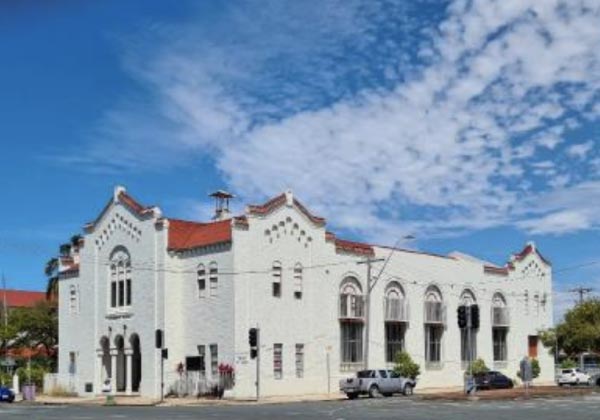
The construction of the Holy Trinity parish hall was noted by Browns son Geffrey Brown to be a favourite of his father’s. Not only for its connection to the Anglican church in Mackay but for prominence of the building as Landmark and for the roll the hall played in the cultural and social fabric of the district. The Holy Trinity parish hall is now home to the Trinity op shop and a number of smaller businesses. The Interiors of the building are currently under restoration be returned in their original designs of HVM Brown.
Another of Browns designs that is protected by state heritage legislation is the former Pioneer Shire Council building in Wood street Mackay. The Chambers were restored in 2015 in a joint project between the Federal government and The Mackay Regional Council.
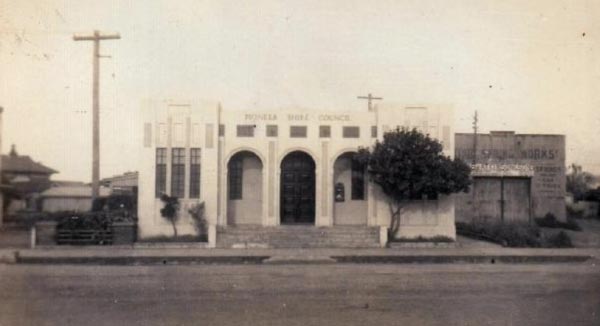
He was the architect of the McGuire’s Hotel, the Oriental Hotel (demolished), the Hotel Mackay, the Imperial Hotel, now known as Wide Bay house as well as the Mackay Fire station (demolished). Brown was the architect responsible for all the Catholic churches in Mackay south of the Pioneer River. He was the architect responsible St Patrick’s Catholic Church in River Street, Francis Xavier Catholic Church and Presbytery in West Mackay, St Mary’s Catholic Church in South Mackay and Saint Michaels in Sarina. Other significant works by Brown still standing are:
- His own home and office, Brisbane Street
- Chaseley House, Sydney Street
- CWA Building, Gordon Street
- RSL Memorial Hall, Sydney Street
- Black’s Building, Victoria Street
- The Shamrock Hotel, Nebo Road
From the outset of his architectural career in Mackay Brown was at the forefront of the new architectural movement sweeping the world. By mid-1920 there was serious interest in European, and United States modern architecture including the jazz-inspired Art Deco and then the Moderne, with its abstracted simplified forms and illusions to ships fast cars and other contemporary machines. Brown utilized these elements throughout his designs for hotels, places of worship and general buildings. From the body of work Brown contributed to in Mackay, it is evident that he favoured the Mediterranean style of inter war architecture, with its expanse of plain walls and limited detailing.
Influential Australian architects brought back the styles from Italy and Spain in the early 20th century convinced that Mediterranean techniques would be well-suited for the Australian climate and lifestyle. Mediterranean style became popular in the 1920s and 1930s. One variant, known as Spanish Mission or Hollywood Spanish, became famous as Australians saw films of and read in magazines about the glamorous mansions in that style that Hollywood movie stars had. Spanish mission houses began to appear in the wealthier suburbs.
Elements of the Mediterranean style can be found in Brown’s designs for the Parish Hall of the Holy Trinity Anglican Church, McGuire’s Hotel, the Blacks Building as well as the Pioneer Shire offices in Wood Street. His use of three arches is a common motif of his work. Brown was noted as preferring to work on corner blocks so to use a rounded corner in many of his designs. He utilized reinforced concrete to create his rounded corners these can be see today in many of his buildings. He utilized the skills of William Guthrie, who established his building company in Mackay in 1921 and constructed a large number of commercial and residential properties in the following decades. It was Guthrie’s expertise of forming reinforced concrete that made Browns designs a reality. Brown revived his use of the aspects of Spanish Mission style for his design of the St Patrick’s Catholic Church built between 1961 and 63.
As architectural styles developed in Australia throughout the 1950s and ’60s many of Brown’s designs, prominent Landmark buildings in Mackay changed with them. Brown brought the modernist style of architecture to Mackay, in building such as the Returned Servicemen League building in Sydney Street. Brown designed a second stage of the heritage-listed Sugar Research Institute at 239 Nebo Road in 1963 that was built in 1966. The first stage was designed by Karl Langer, supervised by Brown and constructed in 1953 by Don Johnstone. Brown was the supervising architect for the Mater hospital and City Cinema projects.
He retired from practice in 1983. His architectural practice of Harold Brown & Associate was taken up by his son Geoffrey Brown in the original office at 14 Brisbane Street. Brown & Associate created the designs for a number of properties in the Mackay’s districts as well as a number of Catholic collages such as Mercy Collage and Saint Ann’s in Sarina. Brown died in 1991, he was one of the true Gentlemen of the Architectural profession and was held in high regard by his clients. Harold Brown was recognized in 2012 for the significance of his contribution to the architectural development of Mackay as part of the 150th-anniversary celebrations. Harold is buried in the Mount Basset Cemetery, Mackay. The Legacy of HVM Brown and the fantastic collection of interwar architecture of the Mackay region is one of the best kept secrets of North Queensland. The Sugar City Art Deco and Modernist Society is a new organization that aims to promote and explore architectural heritage of the Mackay region.
